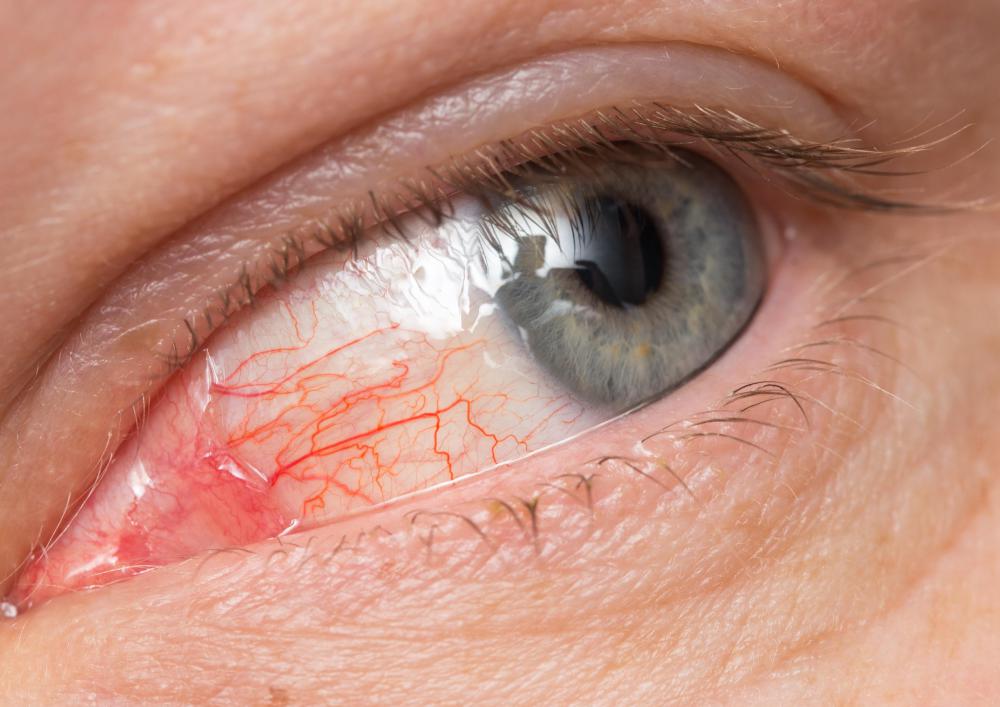At TheHealthBoard, we're committed to delivering accurate, trustworthy information. Our expert-authored content is rigorously fact-checked and sourced from credible authorities. Discover how we uphold the highest standards in providing you with reliable knowledge.
What is the Lamina Papyracea?
The lamina papyracea is a smooth bone plate shaped like a leaf that is commonly known for being situated close to the ethmoid bone in the musculoskeletal system. The ethmoid bone forms the area of the skull at the roof of the nose, where it sets the nasal cavity apart from the brain. Thus the ethmoid is right between the two orbits, which contain the eyes. By extension, the lamina papyracea is also part of the orbit, which is why it is sometimes referred to as the orbital lamina.
The main purpose of this bone is to cover the middle and posterior cells of the ethmoid bone. Its location particularly provides a lateral surface for the ethmodial labyrinth, which is one of the three parts that constitute the ethmoid bone. This function is the reason why it is known by the alternate term orbital plate. Overall, the lamina papyracea forms a huge portion of the orbit's medial wall, which is the structure's middle bone.

The lamina papyracea extends to three out of the seven bones that articulate the orbit. The ethmoid bone is one of these structures. It also touches the frontal bone, which forms the forehead; and the sphenoid, a small structure that sits underneath the frontal bone and behind the ethmoid bone. This is named after its manner of construction. "Lamina" is a term used in anatomy for a thin plate or layer. "Papyracea" originates from "papyrus," a type of paper produced from the Cyperus papyrus plant.

Due to its thin nature, the lamina papyracea can easily fracture. This can be achieved during a fight, with a blow delivered to the eye. Such violent pressure causes the thin layer to push into the ethmoid bone or the maxillary sinus, which is an air-filled space in the upper jaw anatomically known as the maxilla. In fact, the lamina papyracea is the weakest part of the orbit.

When the maxillary sinus is adversely affected by such destruction, it can increase the chance of infection entering and spreading throughout the orbit, which can result in orbital cellulitis. This is a medical condition that involves acute infection of the eye's tissues, with Haemophilus influenzae, Staphylococcus aureus or Streptococcus being the main bacterial culprits. Symptoms include eyelid swelling and redness, fever, limited eye movement, and the eye bulging out of the orbit. If left untreated by antibiotics or surgery, this condition can lead to double vision and a steady decrease in visual perception.
AS FEATURED ON:
AS FEATURED ON:













Discussion Comments
The anatomy of the human skull is so much more complex than it might seem at first glance. I find it particularly interesting that children actually have even more of these little bones, but they fuse together as the child grows.
I shudder to think of anything fracturing my eye socket though. I have a weird thing about anyone touching my eye, and the idea of a doctor having to perform surgery on that area just creeps me out. Luckily, I think most eye socket fractures are caused by car accidents and airbags prevent them from happening so often now.
@browncoat - It's better to use a fist then to try and jab the eye as well, since you'll have better aim.
If you are serious about self defense, though you should take a course in it. It might sound easy to punch someone in the eye and make your escape, but for one thing, the rim of the eye socket is quite bony and strong so if you misjudge it you won't achieve much, and for another, punching anyone at all, even if they are attacking you, doesn't come naturally to a lot of people.
The anatomy of the human body is quite vulnerable if you know what you're doing, but if you don't, and your attacker is much larger or stronger than you, you are relying on luck and that's never a good idea.
I've heard that if you are seriously being attacked, it's a good idea to try and aim for the eye. Obviously this is only in a life or death situation, as you could really hurt the person, as it says in the article.
But, aiming for almost anywhere else on the skull could end up hurting your hand, and not doing much harm. Even a blow to the nose might only annoy an attacker, as a broken nose hurts but doesn't really slow them down.
If you manage to fracture this part of the eye socket though, that really hurts and will definitely stop them in their tracks.
Again, it's something you wouldn't want to do lightly, but if you are about to be raped or killed, it's a thing to keep in mind.
Post your comments